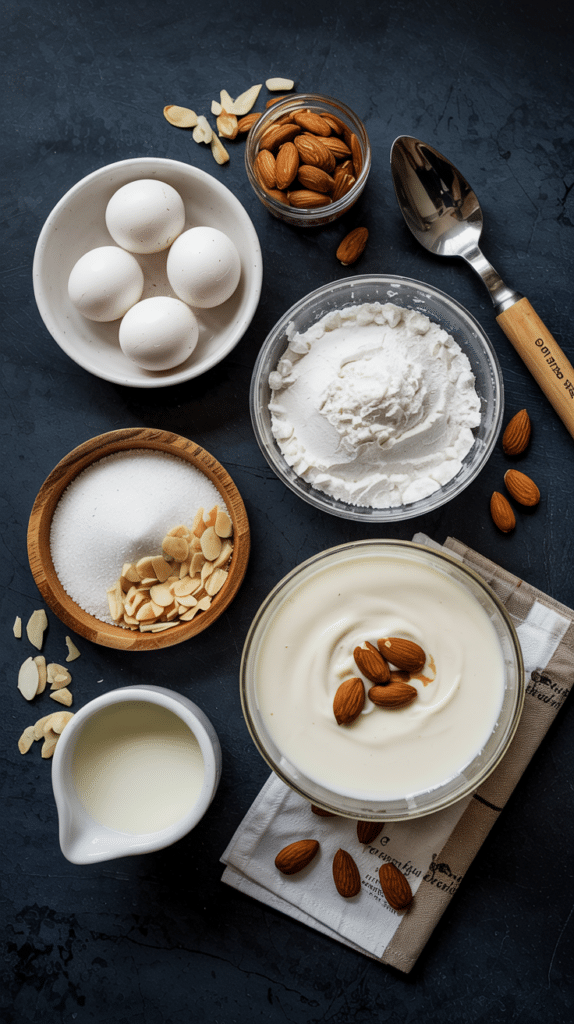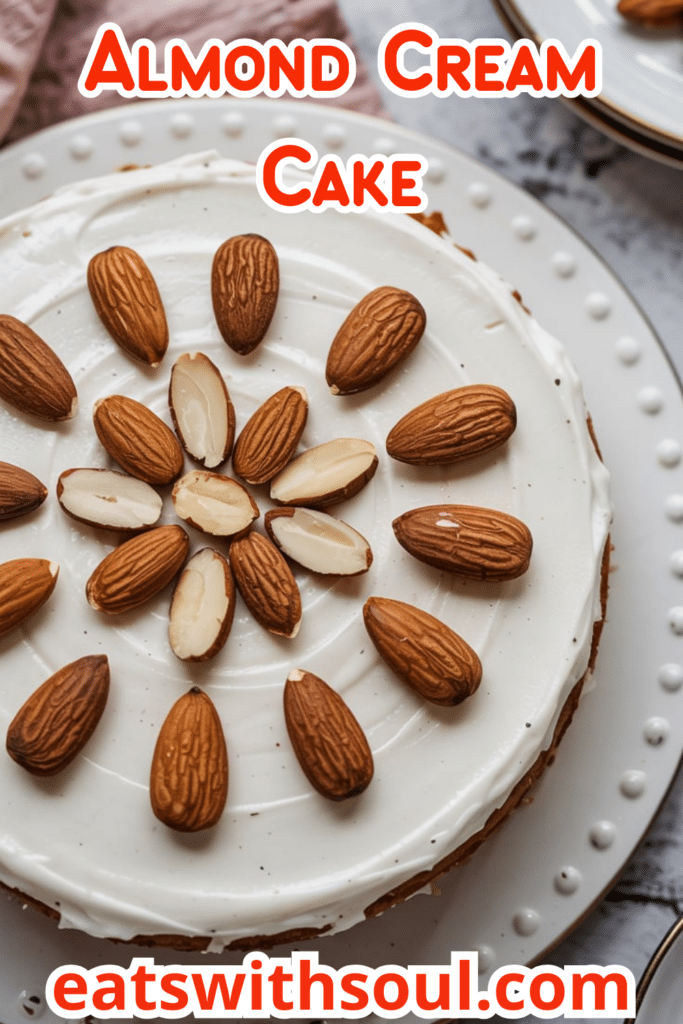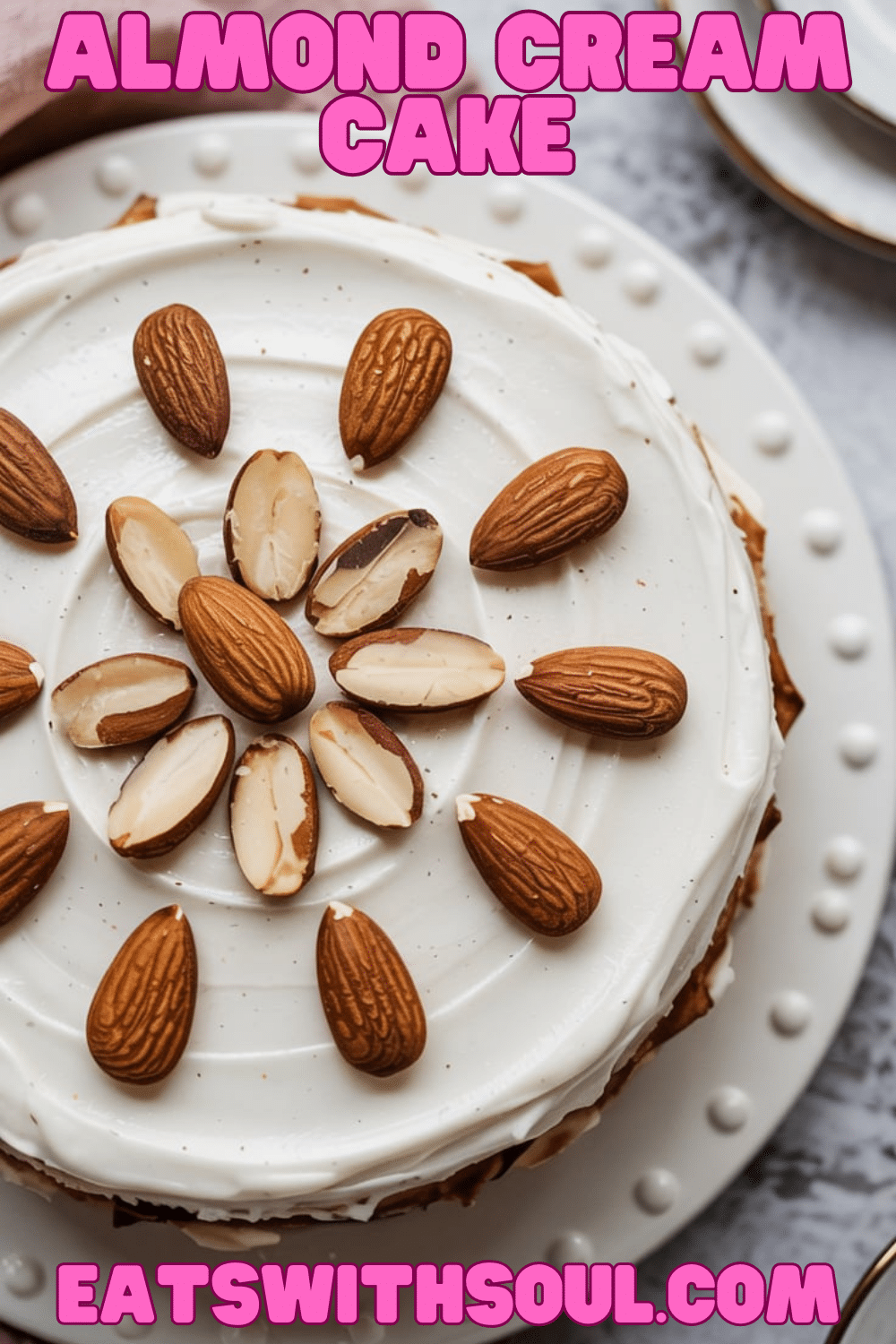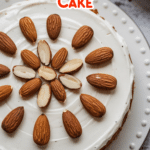Introduction & Inspiration
This Almond Cream Cake is a truly elegant dessert, offering a delicate almond flavor and an incredibly light, tender crumb. The secret lies in using cake flour and folding in stiffly beaten egg whites. What makes it extra special is the frosting – a vintage-style cooked flour (or Ermine) frosting, known for being exceptionally smooth, silky, and much less sweet than traditional American buttercream, perfectly complementing the subtle almond cake.
My inspiration for this recipe comes from a love for classic cake textures and unique frostings. I wanted to create a cake that felt light, sophisticated, and focused on pure almond flavor, enhanced by a frosting that was creamy and luxurious without being overly sugary.
This cake is perfect for showers, tea parties, spring celebrations, or any occasion where a delicate, elegant dessert is desired. It’s a rewarding bake that showcases classic techniques and refined flavors. It is a perfect cake to celebrate.
Nostalgic Appeal
Almond-flavored cakes often evoke a sense of nostalgia, reminiscent of wedding cakes, marzipan treats, or special occasion tortes from European-style bakeries. The light, white cake base itself feels classic and comforting.
The cooked flour frosting, while perhaps less common today, is a nostalgic gem for those who know it. It predates modern American buttercream and was popular mid-century, known for its silky texture and balanced sweetness. It brings a touch of vintage charm to the cake.
This recipe combines the timeless appeal of almond cake with a delightful vintage frosting technique, creating a dessert that feels both sophisticated and deeply satisfying. A perfect dessert, to share with family and friends.
Homemade Focus
This Almond Cream Cake is entirely homemade, celebrating specific baking techniques that yield exceptional results. We’re carefully crafting the cake batter using cake flour and the classic method of folding in whipped egg whites for maximum lightness and tenderness.
The cooked flour frosting is also a key homemade element, requiring the distinct process of making a cooked flour-milk paste, cooling it completely, and then whipping it into creamed butter and sugar until it transforms into a uniquely silky, stable frosting.
Making both components from scratch allows you to experience and control these techniques, resulting in a cake with a texture and flavor profile distinct from typical recipes. The homemade effort truly shines in the delicate crumb and the luxurious frosting. The homemade flavour is incredible.
Flavor Goal
The primary flavor goal is a delicate, clean almond flavor enhanced by vanilla, showcased in a light, tender, and moist cake crumb. The cake itself shouldn’t be overly sweet, allowing the almond notes to come through.
The frosting should be exceptionally smooth, silky, and creamy, with a balanced sweetness and complementary almond flavor. It aims to be less sugary than standard buttercream, letting the butter, cream cheese (recipe uses cream cheese in ingredient description but not in frosting ingredient list – Correction: Rereading, the frosting ingredients do NOT list cream cheese, only butter. The description in instructions mentions cream cheese but ingredients list prevails. This is a butter-based Ermine frosting.), and almond notes shine. The frosting should enhance, not overwhelm, the delicate cake.
The overall experience should be light, airy, sophisticated, and subtly sweet, with a focus on pure almond flavor and luxurious, silky textures. A perfect balance between texture and flavour.
Ingredient Insights
For the Cake:
- Egg Whites* (3/4 cup + 3 tablespoons): Whipped separately and folded in, this is key to the cake’s light, airy texture. This unusual measurement likely corresponds to a specific number of large egg whites (around 5-6). Use fresh whites, at room temperature.
- Salted Butter (1 cup / 8 oz, Room Temperature): Adds flavor, richness, and tenderness. Using salted butter requires adjusting or omitting added salt. Note: Cake salt amount is low (1/2 tsp), likely accounting for salted butter. Must be properly softened.
- Granulated Sugar (300g / 1 1/2 cups): Sweetens the cake and aids in creaming.
- Cake Flour* (345g / 3 cups): Essential for a tender, delicate crumb due to its lower protein content. Spoon and level carefully.
- Salt (3g / 1/2 tsp): Balances sweetness, enhances flavors.
- Baking Powder (6g / 2 tsp): Primary leavening agent.
- Milk (2% milkfat specified, 240ml / 1 cup / 8 oz): Adds moisture. Room temperature preferred.
- Almond Extract (4g / 1 tsp): Provides the primary almond flavor. Use pure extract.
For the Cooked Flour (Ermine) Frosting:
- All-Purpose Flour (83g / 1/2 cup + 2 tbsp): Cooked with milk to form a thick paste (a “roux”), which forms the base of the frosting, giving it stability and smoothness without excessive sugar.
- 2% Milk (16 oz / 2 cups): The liquid used to cook the flour paste.
- Almond Extract (6g / 1 1/2 tsp): Flavors the frosting.
- Granulated Sugar (400g / 2 cups): Sweetens the frosting. Processing it finer helps it dissolve better when creamed with butter.
- Salted Butter (1 pound / 2 cups / 4 sticks, Softened): Whipped until fluffy, then combined with the cooled flour paste. Must be fully softened. Using salted butter adds flavor balance.
- Milk (As Needed): Optional, used sparingly only if needed to adjust final consistency.
For Decorating:
- Sliced Almonds & Whole Almonds: Provide decoration and reinforce the almond theme. Toasting sliced almonds can enhance flavor.
Essential Equipment
- Two 8-Inch Round Cake Pans: For baking the layers.
- Parchment Paper (Recommended): For lining pan bottoms.
- Grease & Flour (or Baking Spray): For preparing pans.
- Stand Mixer (Highly Recommended): With whisk and paddle attachments. Essential for whipping egg whites properly and beating the ermine frosting sufficiently.
- Mixing Bowls (Multiple Sizes): For cake components, frosting paste.
- Whisk: For dry ingredients and making the flour paste.
- Saucepan (Medium): For cooking the flour paste for the frosting.
- Bowl of Ice (Optional): For quick-cooling the flour paste.
- Rubber Spatula: For folding egg whites, scraping bowls.
- Food Processor (Optional): For processing sugar finer for frosting.
- Wire Cooling Racks: Crucial for cooling cake layers completely.
- Offset Spatula: For frosting the cake smoothly.
- Serving Plate or Cake Stand:
Ingredients
(US Customary first, Metric/Grams in parentheses)
Cake:
- ¾ cup plus 3 tablespoons egg whites* (from approx. 5-6 large eggs)
- 1 cup salted butter, room temperature (8 ounces / 226g)
- 1 1/2 cups granulated sugar (300 grams)
- 3 cups cake flour* (345 grams), spooned & leveled
- ½ teaspoon salt (3 grams)
- 2 teaspoons baking powder (6 grams)
- 1 cup 2% milk (8 ounces / 240ml), room temperature
- 1 teaspoon almond extract (4 grams)
Frosting (Cooked Flour/Ermine):
- ½ cup plus 2 tablespoons all-purpose flour (83 grams)
- 2 cups 2% milk (16 ounces / 480ml)
- 1 ½ teaspoons almond extract (6 grams)
- 2 cups granulated sugar (400 grams), processed finer if possible
- 2 cups salted butter, softened (1 pound / 454g)
- Milk, as needed (1 tablespoon at a time)
Decoration:
- Sliced almonds and whole almonds
Notes from Recipe: *Egg Whites: Ensure no yolk contamination. Room temperature whips best. *Cake Flour: Spoon into measuring cup and level off, do not scoop directly.

Step-by-Step Instructions
1. Prepare Egg Whites:
- Separate your eggs, placing ¾ cup plus 3 tablespoons of egg whites into the clean, grease-free bowl of your stand mixer fitted with the whisk attachment. (Save yolks for another use).
- Let the egg whites sit at room temperature if they were cold.
- Beat the egg whites on medium-high speed until stiff peaks form (the peaks stand straight up when the whisk is lifted). This may take a minute or two.
- Gently transfer the whipped egg whites to another bowl and place them in the refrigerator until needed later.
2. Prepare Oven and Pans:
- Preheat the oven to 350ºF (175°C).
- Grease and flour two 8-inch round cake pans. Lining the bottoms with parchment paper is also recommended.
3. Cream Butter and Sugar:
- Place the 1 cup of room temperature salted butter in the now-empty mixer bowl (no need to wash if only egg whites were in it). Fit the paddle attachment.
- Cream the butter on medium speed for about 2 minutes until it is lighter in color and creamy.
- Add the 1 1/2 cups granulated sugar to the butter and beat on medium-high speed until light and fluffy (about another 1-2 minutes). Scrape down the bowl.
4. Combine Dry and Wet Cake Ingredients:
- In a small bowl, whisk together the 3 cups cake flour, 1/2 tsp salt, and 2 tsp baking powder. Set aside.
- In another small bowl or measuring cup, combine the 1 cup milk and 1 tsp almond extract.
- With the mixer on low speed, add the dry ingredients to the butter/sugar mixture alternately with the milk mixture, beginning and ending with the dry ingredients (Dry-Milk-Dry-Milk-Dry). Mix only until just combined after each addition.
5. Fold in Egg Whites:
- Remove the bowl from the mixer. Add the stiffly beaten egg whites to the cake batter.
- Gently fold the egg whites into the batter using a large rubber spatula, cutting down through the middle and bringing batter up from the bottom, until just combined and no large streaks of egg white remain. Do not overmix, as this will deflate the batter.
6. Bake the Cakes:
- Pour the cake batter equally into the two prepared cake pans. Smooth the tops gently.
- Bake for 25-27 minutes, or until the top bounces back when lightly touched and a toothpick inserted into the center comes out clean.
- Allow the cakes to cool in the pans on wire racks for 10 minutes.
- Loosen the edges with a thin knife and carefully invert the cakes onto the wire racks. Remove parchment paper and allow them to cool completely.
7. Make the Frosting (Cooked Flour Paste):
- While the cakes cool, prepare the frosting base. In a medium saucepan, whisk the 1/2 cup plus 2 tablespoons all-purpose flour into the 2 cups of milk until completely smooth with no lumps.
- Place the saucepan over medium-low heat. Cook, whisking constantly, until the mixture thickens considerably, resembling mashed potatoes or thick pudding. Keep stirring and scraping the bottom to prevent scorching. Lower the heat if needed. This step takes time, about 12-15 minutes.
- Remove the thickened paste from the heat. Cool Completely: Transfer the paste to a bowl. Press plastic wrap directly onto the surface to prevent a skin from forming. Cool completely to room temperature. To speed this up, set the bowl in an ice bath for 5-10 minutes, stirring occasionally, then let finish cooling at room temp. The paste MUST be fully cooled before combining with the butter.
- Once cool, stir in the 1 1/2 teaspoons almond extract.
8. Finish the Frosting:
- Optional Sugar Prep: If desired, process the 2 cups granulated sugar in a food processor for a minute to make the granules finer (helps dissolve better).
- In the clean bowl of your stand mixer fitted with the paddle attachment (or using a hand mixer), cream the 2 cups of softened salted butter and the processed granulated sugar together on medium-high speed until very light and fluffy (at least 5 minutes). Scrape the bowl well. Ensure the sugar feels dissolved and not grainy.
- Reduce mixer speed to low. Add the completely cooled flour/milk/almond paste to the creamed butter/sugar mixture, a spoonful at a time.
- Once all the paste is added, increase the speed to medium-high and beat until everything combines and looks like light, fluffy whipped cream. This final whipping incorporates air and creates the silky texture, taking about 3-5 minutes. Keep scraping the sides of the bowl.
- Check consistency. If it seems too stiff, beat in milk, 1 tablespoon at a time (unlikely to be needed unless butter was cold).
9. Assemble and Decorate:
- Ensure cake layers are completely cool. If desired, level the tops.
- Place one cake layer on your cake plate. Spread a generous layer of the ermine frosting on top.
- Place the second cake layer on top (inverted for a flat top is good).
- Use the remainder of the frosting to frost the top and sides of the cake smoothly or decoratively.
- Decorate the sides and top with sliced and/or whole almonds as desired.
10. Chill (Optional but Recommended):
- Chill the cake briefly (30 minutes) to help the frosting set before slicing. Serve closer to room temperature.

Troubleshooting
- Cake Dense/Not Airy: Egg whites under-whipped or deflated during folding. Overmixing batter after adding flour. Baking powder/soda old.
- Cake Dry: Overbaking. Check doneness carefully.
- Frosting Paste Lumpy: Flour not fully whisked into milk before cooking, or not stirred constantly during cooking causing scorching/lumps. Strain paste after cooking if necessary.
- Frosting Grainy: Sugar not fully dissolved when creamed with butter (processing helps), or flour paste added while still warm, melting the sugar/butter. Ensure paste is completely cool.
- Frosting Separated/Weeping: Often due to temperature differences (paste too warm, butter too cold/warm) or being over/under beaten at final stage. Try beating longer on medium-high; sometimes it comes back together.
Tips and Variations
- Whipping Egg Whites: Use a spotlessly clean, grease-free bowl and beaters. Room temperature whites yield more volume.
- Folding Egg Whites: Be gentle! Cut down the middle, scrape across the bottom, and fold up and over, rotating the bowl. Stop when just combined.
- Cooling Flour Paste: This is CRITICAL for ermine frosting. It must be completely at room temperature or cool before adding to the butter, otherwise the butter will melt.
- Frosting Texture: Ermine frosting is known for being silky and less sweet than American buttercream. Don’t expect the same super-sweet taste. Beat it well at the end to get it fluffy.
- Extracts: Substitute some or all almond extract with vanilla if preferred, or add a touch of orange blossom water for a different floral note.
- Nuts: Fold finely chopped toasted almonds into the frosting or cake batter.
Serving and Pairing Suggestions
- Serve at Cool Room Temperature: Allows the delicate cake texture and silky frosting to shine.
- Tea Parties/Brunches: Perfect for elegant daytime events.
- With Fresh Berries: A side of raspberries or sliced peaches complements the almond flavor.
- With Coffee or Tea: Ideal pairings.
Nutritional Information
(Note: Estimated, per slice, assuming 12 slices)
- Calories: 500-650+
- Fat: 30-45g+
- Saturated Fat: 15-25g+
- Cholesterol: 100-140mg+
- Sodium: 200-300mg+ (Using salted butter increases this)
- Total Carbohydrates: 55-70g+
- Dietary Fiber: <1-2g
- Sugars: 35-50g+
- Protein: 5-7g+
Delicate Almond Cream Cake with Silky Ermine Frosting
Bake a beautiful Almond Cream Cake! This recipe features a light, tender almond-flavored cake made with whipped egg whites and a uniquely smooth, less-sweet cooked flour (ermine) frosting.
Ingredients
(US Customary first, Metric/Grams in parentheses)
Cake:
- ¾ cup plus 3 tablespoons egg whites* (from approx. 5–6 large eggs)
- 1 cup salted butter, room temperature (8 ounces / 226g)
- 1 1/2 cups granulated sugar (300 grams)
- 3 cups cake flour* (345 grams), spooned & leveled
- ½ teaspoon salt (3 grams)
- 2 teaspoons baking powder (6 grams)
- 1 cup 2% milk (8 ounces / 240ml), room temperature
- 1 teaspoon almond extract (4 grams)
Frosting (Cooked Flour/Ermine):
- ½ cup plus 2 tablespoons all-purpose flour (83 grams)
- 2 cups 2% milk (16 ounces / 480ml)
- 1 ½ teaspoons almond extract (6 grams)
- 2 cups granulated sugar (400 grams), processed finer if possible
- 2 cups salted butter, softened (1 pound / 454g)
- Milk, as needed (1 tablespoon at a time)
Decoration:
- Sliced almonds and whole almonds
Notes from Recipe: *Egg Whites: Ensure no yolk contamination. Room temperature whips best. *Cake Flour: Spoon into measuring cup and level off, do not scoop directly.
Instructions
1. Prepare Egg Whites:
- Separate your eggs, placing ¾ cup plus 3 tablespoons of egg whites into the clean, grease-free bowl of your stand mixer fitted with the whisk attachment. (Save yolks for another use).
- Let the egg whites sit at room temperature if they were cold.
- Beat the egg whites on medium-high speed until stiff peaks form (the peaks stand straight up when the whisk is lifted). This may take a minute or two.
- Gently transfer the whipped egg whites to another bowl and place them in the refrigerator until needed later.
2. Prepare Oven and Pans:
- Preheat the oven to 350ºF (175°C).
- Grease and flour two 8-inch round cake pans. Lining the bottoms with parchment paper is also recommended.
3. Cream Butter and Sugar:
- Place the 1 cup of room temperature salted butter in the now-empty mixer bowl (no need to wash if only egg whites were in it). Fit the paddle attachment.
- Cream the butter on medium speed for about 2 minutes until it is lighter in color and creamy.
- Add the 1 1/2 cups granulated sugar to the butter and beat on medium-high speed until light and fluffy (about another 1-2 minutes). Scrape down the bowl.
4. Combine Dry and Wet Cake Ingredients:
- In a small bowl, whisk together the 3 cups cake flour, 1/2 tsp salt, and 2 tsp baking powder. Set aside.
- In another small bowl or measuring cup, combine the 1 cup milk and 1 tsp almond extract.
- With the mixer on low speed, add the dry ingredients to the butter/sugar mixture alternately with the milk mixture, beginning and ending with the dry ingredients (Dry-Milk-Dry-Milk-Dry). Mix only until just combined after each addition.
5. Fold in Egg Whites:
- Remove the bowl from the mixer. Add the stiffly beaten egg whites to the cake batter.
- Gently fold the egg whites into the batter using a large rubber spatula, cutting down through the middle and bringing batter up from the bottom, until just combined and no large streaks of egg white remain. Do not overmix, as this will deflate the batter.
6. Bake the Cakes:
- Pour the cake batter equally into the two prepared cake pans. Smooth the tops gently.
- Bake for 25-27 minutes, or until the top bounces back when lightly touched and a toothpick inserted into the center comes out clean.
- Allow the cakes to cool in the pans on wire racks for 10 minutes.
- Loosen the edges with a thin knife and carefully invert the cakes onto the wire racks. Remove parchment paper and allow them to cool completely.
7. Make the Frosting (Cooked Flour Paste):
- While the cakes cool, prepare the frosting base. In a medium saucepan, whisk the 1/2 cup plus 2 tablespoons all-purpose flour into the 2 cups of milk until completely smooth with no lumps.
- Place the saucepan over medium-low heat. Cook, whisking constantly, until the mixture thickens considerably, resembling mashed potatoes or thick pudding. Keep stirring and scraping the bottom to prevent scorching. Lower the heat if needed. This step takes time, about 12-15 minutes.
- Remove the thickened paste from the heat. Cool Completely: Transfer the paste to a bowl. Press plastic wrap directly onto the surface to prevent a skin from forming. Cool completely to room temperature. To speed this up, set the bowl in an ice bath for 5-10 minutes, stirring occasionally, then let finish cooling at room temp. The paste MUST be fully cooled before combining with the butter.
- Once cool, stir in the 1 1/2 teaspoons almond extract.
8. Finish the Frosting:
- Optional Sugar Prep: If desired, process the 2 cups granulated sugar in a food processor for a minute to make the granules finer (helps dissolve better).
- In the clean bowl of your stand mixer fitted with the paddle attachment (or using a hand mixer), cream the 2 cups of softened salted butter and the processed granulated sugar together on medium-high speed until very light and fluffy (at least 5 minutes). Scrape the bowl well. Ensure the sugar feels dissolved and not grainy.
- Reduce mixer speed to low. Add the completely cooled flour/milk/almond paste to the creamed butter/sugar mixture, a spoonful at a time.
- Once all the paste is added, increase the speed to medium-high and beat until everything combines and looks like light, fluffy whipped cream. This final whipping incorporates air and creates the silky texture, taking about 3-5 minutes. Keep scraping the sides of the bowl.
- Check consistency. If it seems too stiff, beat in milk, 1 tablespoon at a time (unlikely to be needed unless butter was cold).
9. Assemble and Decorate:
- Ensure cake layers are completely cool. If desired, level the tops.
- Place one cake layer on your cake plate. Spread a generous layer of the ermine frosting on top.
- Place the second cake layer on top (inverted for a flat top is good).
- Use the remainder of the frosting to frost the top and sides of the cake smoothly or decoratively.
- Decorate the sides and top with sliced and/or whole almonds as desired.
10. Chill (Optional but Recommended):
- Chill the cake briefly (30 minutes) to help the frosting set before slicing. Serve closer to room temperature
Recipe Summary and Q&A
Summary: This Almond Cream Cake features light, tender cake layers achieved using cake flour and folded-in whipped egg whites, flavored with almond extract. It’s frosted with a classic cooked flour (ermine) frosting, also almond-flavored, known for its silky texture and balanced sweetness. The process involves whipping egg whites, making the cake batter, baking and cooling, preparing the cooked flour paste for frosting, cooling the paste completely, then whipping it into creamed butter and sugar, and finally assembling and decorating the cake.
Q&A:
- Q: What is Ermine Frosting / Cooked Flour Frosting?
- A: It’s a vintage type of frosting made by cooking flour and milk into a thick paste, cooling it completely, and then whipping that paste into creamed butter and sugar. It results in a very smooth, silky, stable frosting that’s significantly less sweet than typical American powdered sugar buttercream.
- Q: Why whip the egg whites separately?
- A: Whipping egg whites to stiff peaks and folding them into the batter incorporates a lot of air, creating a lighter, more delicate cake crumb, which is characteristic of some sponge or chiffon-style cakes, and works well with cake flour here for an airy texture.
- Q: Can I use all-purpose flour instead of cake flour?
- A: Cake flour is recommended for the most tender result. If substituting AP flour, use the method of replacing 2 tbsp flour with 2 tbsp cornstarch per cup, and sift well. The texture will be slightly less delicate.
- Q: My frosting didn’t get fluffy like whipped cream. What did I do wrong?
- A: Ermine frosting’s final texture relies on beating the cooled paste thoroughly into well-creamed butter and sugar. Ensure the butter/sugar was beaten for the full 5 minutes until very light. Ensure the paste was completely cool. Beat the final mixture for the full 3-5 minutes described. It should resemble thick, silky whipped cream, not necessarily airy like pure whipped cream, but very light and fluffy for a buttercream.

